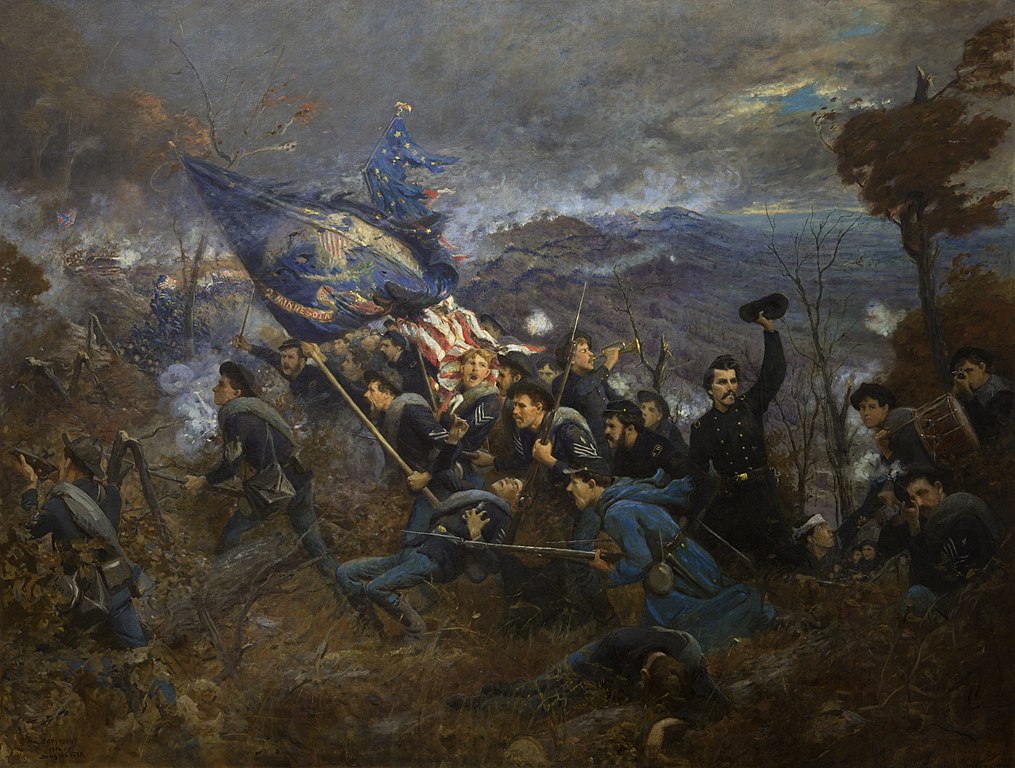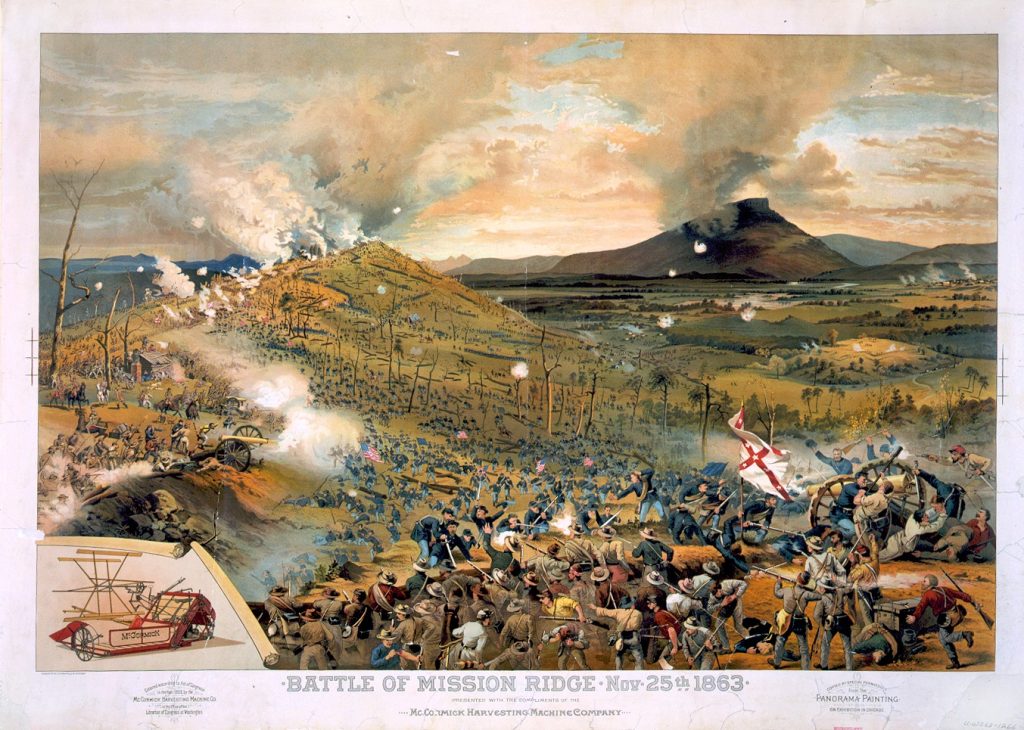Colonel Ferdinand Van Derveer ‘s Report on His Brigade’s Action in the Battle of Missionary Ridge
After U.S. forces under Major General Joseph Hooker captured Lookout Mountain at Chattanooga, Tennessee on November 24th, 1863, General Braxton Bragg’s Confederates withdrew and set up defensive positions on Missionary Ridge. Hooker’s troops were on the Confederate left, or south side of Missionary Ridge and Major General William T. Sherman’s Army of the Tennessee was on the right, or north end, of the ridge. Major General Ulysses S. Grant, in overall charge of Union forces, ordered an attack by Sherman on the Rebel right for the next day.
On the morning of November 25th, Sherman attacked but the Confederate defenses held him in check. Grant then ordered Major General George Thomas to assault the center of Missionary Ridge to help relieve the pressure on Sherman. Thomas deployed four divisions under Brigadier Generals Absalom Baird and Thomas J. Wood, Major General Philip Sheridan, (three brigades in each division) and Brigadier General Richard W. Johnson (two brigades), from the Union left to right.
Colonel Ferdinand Van Derveer commanded the 2nd Brigade of Baird’s division, part of the Union 14th Corps. The brigade consisted of the 75th, 87th, and 101st Indiana; the 9th, 35th, and 105th Ohio; and the 2nd Minnesota Infantry regiments. Van Derveer deployed his regiments in two lines with the 2nd Minnesota in front of the rest of the brigade.
At 4:00 p.m., the Federals were ordered forward, with the objective of taking the Confederate rifle pits at the base of the ridge. The assault was successful, with the Confederates driven from the rifle pits and back up the ridge. Some unit commanders were unclear if they were to continue the assault up the ridge or hold position in the rifle pits, but with enemy fire now raining down on them and the position becoming untenable, the U.S. troops charged up the slope and drove the Rebels off the crest of Missionary Ridge.
Colonel Van Derveer filed this after action report which provides a good narrative of his brigade’s fighting in the Battle of Missionary Ridge:
Hdqrs. Second Brig., Third Div., 14th Army Corps.
Chattanooga, Tenn., December 5, 1863.Captain: I have the honor to report the part taken by the Second Brigade in the late engagements in front of Chattanooga.
My command consisted of the Ninth Ohio Volunteers, Col. G. Kammerling; the Seventy-fifth Indiana, Col. M. S. Robinson; the Eighty-seventh Indiana, Col. Newell Gleason; One hundred and fifth Ohio, Lieut. Col. W. R. Tolles; One hundred and first Indiana, Lieut. Col. Thomas Doan; Second Minnesota, Lieut. Col. J. W. Bishop; and the Thirty-fifth Ohio. Lieutenant-Colonel Boynton, numbering in all 102 commissioned officers and 1,577 enlisted men.
Having been supplied with 100 rounds of ammunition to the man, on the afternoon of the 23d of November. I moved to a position three-quarters of a mile in front of Fort Phelps, with my brigade formed in two lines, the left resting upon the Moore road and the right near General Turchin’s brigade. Here we remained in line, with a strong picket in front, until 8 a. m. on the 25th, when, in pursuance of orders from the general commanding the division, I deployed one regiment (Thirty-fifth Ohio) along my front and advanced it near a mile without opposition, the enemy’s pickets having been withdrawn about daybreak that morning, and several small parties left for observation retiring in haste on our approach. Afterward this regiment was ordered to rejoin the brigade, when the division was moved to the left, to and beyond Citico Creek, crossing it near its mouth. Passing but a short distance from this creek an order came to countermarch, and we returned and took position about half a mile north of Bald Hill, facing and 1,200 yards distant from Missionary Ridge. At this point I formed my brigade in two lines, the first composed of the Eighty-seventh Indiana on the right, the One hundred and first Indiana on the left, and the Thirty fifth Ohio in the center. The second line was formed by Seventy fifth Indiana and One hundred and fifth and Ninth Ohio Regiments. The Second Minnesota was placed in front of the brigade, with two companies, under command of Captain Uline, deployed as skirmishers, and the residue of the regiment behind them as a reserve.
I ordered my skirmishers to advance to the far side of the woods, examine the position of the enemy, and report their apparent force in and about the rifle-pits at the foot of the ridge. After remaining in this place for an hour I was ordered to move forward and take the rifle-pits. This was about 4 p. m. I sent word to Lieutenant-Colonel Bishop to move at once with his skirmishers and reserve, and pushed up the brigade to keep within supporting distance. The rifle-pits in our front appeared to be occupied by two battalions of the enemy, two stand of colors being visible upon their works. The skirmishers advanced gallantly into the open field, and, under a heavy fire from the enemy’s artillery on the ridge and musketry from the lower works, dashed forward at a double-quick without firing a shot. As they approached within 150 yards of the enemy great uneasiness was apparent among the men in the rifle-pits, and by the time our skirmishers were at a distance of 100 yards they were retreating precipitately up the ridge to their rear.
Lieutenant-Colonel Bishop immediately got his command under cover of the enemy’s works, and within five minutes of this time, my first line having passed the open space under a very heavy direct and enfilading fire from the enemy’s batteries on the ridge, were also partially under cover of the same works. In the meantime, my second line was brought forward into the open ground and the men ordered to lie down. Fifteen minutes after the rifle-pits were taken, the general commanding the division ordered a charge upon the crest of the ridge. My brigade moved at once with cheers and a hearty good will, the Second Minnesota occupying a position in the first line. Thie precipitous ascent, the enemy’s sharpshooters in front, and the terrific enfilading artillery fire upon each flank were forgotten in their eager haste to storm the heights. My second line came forward at a run, and after a few moments rest at the foot of the ridge followed closely the advance. In fifteen minutes more our colors were upon the summit, and in twenty the rebels had been driven out of their works on the crest, and we occupied the ground in front of the brigade. As my men sprang over the works the enemy’s cannoneers were caught in the act of loading and were bayoneted or driven off before they could fire their pieces. Five guns were found here in position and captured by the brigade, two by the Second Minnesota and three by the Thirty-fifth Ohio. The larger part of the enemy retired along the ridge toward the left, vigorously pursued, and driven near half a mile. For thirty minutes a very determined resistance was made by the enemy. Many of the troops of my command, having in the charge up the ridge lost their regimental organizations, were in some disorder for a short time, but all pressed toward the enemy. The Ninth Ohio and Seventy-fifth Indiana came up in good order, and were placed in line perpendicular to the ridge and fronting the rebels.
Darkness coming on firing ceased upon both sides, and my brigade bivouacked on the crest of Missionary Ridge. After the action one other piece of artillery, abandoned by the enemy, was found by the Seventy-fifth Indiana and taken charge of. The guns that were captured by my command were left where found, while our men pursued the enemy along the ridge toward Tunnel Hill. While they were thus absent the pieces were hauled off to our rear by men said to belong to Brigadier-General Wood’s division, which was upon the right. I saw these guns being taken toward the ground occupied by that division, and upon inquiry I was informed that they were being taken to a position where they could be used against the enemy. My brigade at the same time captured one caisson with 6 horses attached, and a limber with one pair of horses. These, too, were taken to the rear with the guns. No other troops were near this battery when taken. The enemy were driven from it by my own men, and we thus lost possession while gallantly engaging the retreating rebel force. The next day I moved with the rest of the division to McAfee’s Church, and the succeeding day to Ringgold. We were not, however, actively engaged, and on the 29th marched back to our camp at Chattanooga.
My loss upon the 25th was 2 officers killed and 13 wounded, 20 enlisted men killed and 126 wounded.
In this action my brigade fully sustained the reputation it had won at Chickamauga. None flinched from their duty. I particularly commend the conduct of Colonel Kammerling, Ninth
Ohio; Colonel Robinson, Seventy-fifth Indiana; Colonel Gleason, Eighty seventh Indiana; Lieutenant-Colonel Tolles, One hundred and fifth Ohio; Lieutenant-Colonel Doan, One hundred and first Indiana; Lieutenant-Colonel Bishop, Second Minnesota, and Lieutenant- Colonel Boynton, Thirty-fifth Ohio. These officers discharged their duties coolly and ably.
Lieutenant-Colonel Boynton was severely wounded early in the engagement, when the command of his regiment devolved upon Major Budd, who is entitled to much praise for the energy and skill he exhibited in leading his men up the ridge.
Especial credit is due Lieutenant-Colonel Bishop for the management of his regiment when skirmishing in front of the brigade, and the gallant manner in which his command carried the rifle-pits at the foot of the ridge. There are many line officers and enlisted men who deserve commendation for their gallantry. For their names I respectfully refer you to the reports of regimental commanders.
The members of my staff present with me on the field were Capt. J. R. Beatty, acting assistant adjutant-general; Capt. C. A. Cilley, brigade inspector; Capt. W. R. Tuttle, brigade engineer; First Lieut. S. Fortner, provost-marshal; First Lieut. S. D. Parsons, acting assistant quartermaster. and First Lieut. C. B. Williams, aide-de-camp. They rendered me great service, and are entitled to praise for their gallant conduct.
I am, captain, very respectfully, your obedient servant,
FERDINAND VAN DERVEER,
Colonel, Commanding Brigade.Capt. A. C. McClurg, Actg. Asst. Adjt. Gen.
Van Derveer was obviously not happy that others took credit for the capture of the enemy artillery that his men had captured.
Lieutenant Colonel Boynton of the 35th Ohio, wounded in action while leading his regiment in battle, was awarded the Medal of Honor
Sources:
Deeds of Valor: How America’s Heroes won the Medal of Honor by Walter F. Beyer and Oscar F. Keydel
Grant Takes Command by Bruce Catton
Official Records of the Union and Confederate Armies in the War of the Rebellion, Series I, Volume 31, Part 2
The Shipwreck of Their Hopes: The Battles for Chattanooga by Peter Cozzens
Amazon affiliate links: We may earn a small commission from purchases made from Amazon.com links at no cost to our visitors. For more info, please read our affiliate disclosure.









